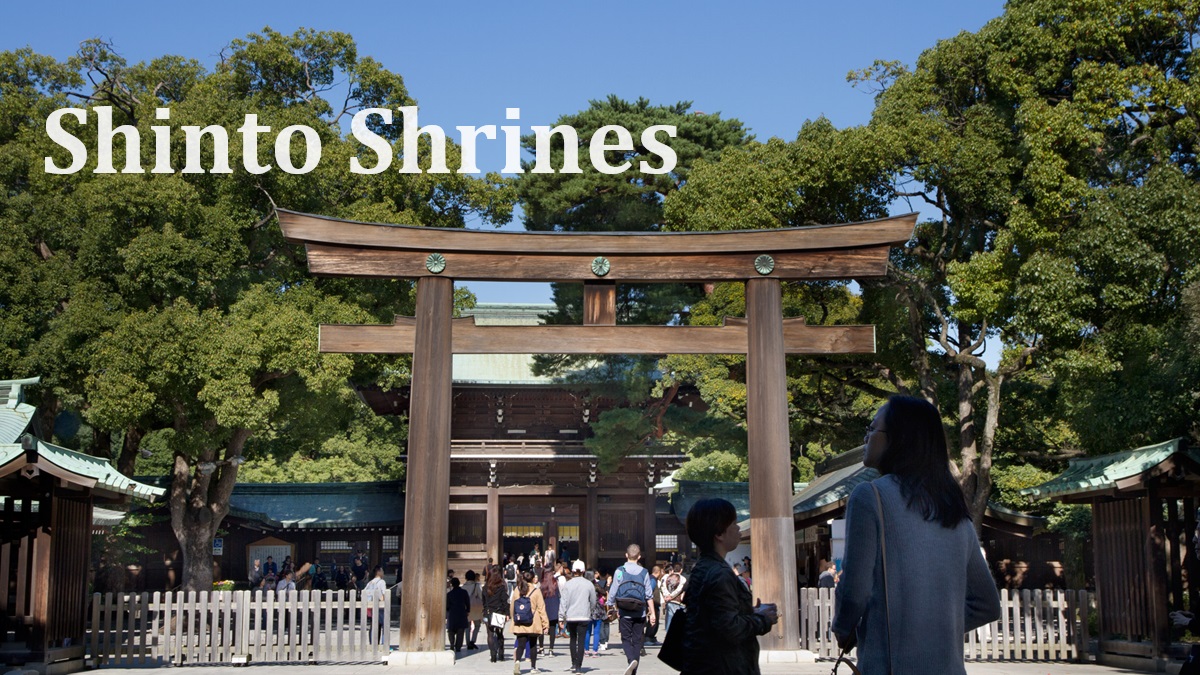Shinto shrine in Japan
Shinto shrine is called "Jinja" in Japanese.
Large or prestigious shrines are called "xx-jingu" or "xx-taisha".
Shinto is the native religion of Japan since ancient times.
Many gods dwell in the nature and around us and they are always watching us.
And, the soul of a dead person becomes a god, and it lives in the house as the guardian deity.
That is the idea of Shinto, so there are uncountable gods in Japan.
There are more than 80,000 Shinto shrines in Japan, so we can find them in any city, town or village.

Torii gate in Meiji Shrine in Tokyo
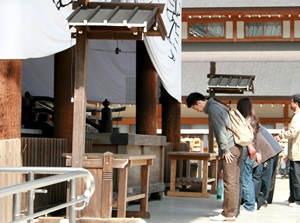
Worshippers in Yasukni Shrine in Tokyo
At the entrance of Shinto shrine, "Torii" gate stands.
Two crosspieces are set on top of two upright pillars, so you can find the shrine easily.
Worshippers step forward to the front of the worship hall.
The manner of worshipping is "Twice bowing, twice clapping and one-time bowing".
It is only for a few seconds.
After worshipping, worshipper can buy the lucky charm and draw "Omikuji" (a fortune-telling slip).
It is said that the imperial family is the descendant of gods who created Japan in the mythical age.
Therefore, Japanese Emperor System is closely related to Shinto.
Both Shinto and Buddhism have been believed by Japanese people, and they are not conflicting religions.
About Shinto and Buddhism, see the following page.
Ise Shrine (Ise-jingu)
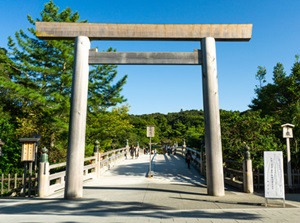
Ujibashi bridge, the entrance to Ise-jingu
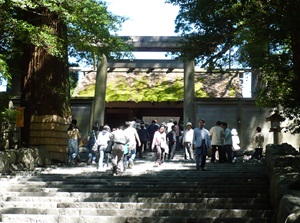
Main Shrine of Ise-jingu
Ise-jingu (伊勢神宮, Mie Pref.) is the highest and special rank of all Shinto shrines in Japan, and it is in Ise city in Mie Prefecture.
It is unknown when the shrine was founded.
There are various theories of the foundation year from 4 BC to the 7th century AD.
Ise Shrine enshrines the gods who created Japan in the Japanese mythology.
It is said that they are the ancestors of current Japanese Imperial Family.
Ise-jingu has two sites of shrine.
Geku (外宮, Outer shrine) is in the center of Ise city, and Naiku (内宮, Inner shrine) is by a sacred river and a vast forest in the suburbs of the city.
Worshippers should visit both shrines formally, but visiting only Naiku is also OK.
There is a street of souvenir shops near the entrance of Naiku, and it is always full with the people after worshipping.
By the way, all buildings of Ise-jingu are rebuilt every 20 years.
It is said that one of the purposes is to hand down the traditional techniques of rebuilding.
The rebuilding is held for several years as the big event of Ise-jingu.
The first rebuilding was held in 690, and the 62nd rebuilding was completed in 2013.
The 63rd rebuilding will be completed in 2033.
Popular Shinto Shrines in each region
Hokkaido Tohoku Kanto Koshin-etsu Hokuriku Tokai Kansai Chugoku Shikoku Kyushu
Popular Shinto shrines in Hokkaido Region
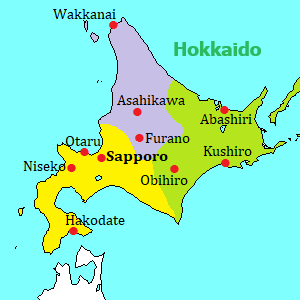
Hokkaido had been an uncolonized land until the 19th century.
So, there are many shrines which were built after the period.
Hokkaido-jingu (北海道神宮, Sapporo city) was built in 1871.
At that time, Russia was advancing to the northeast of Hokkaido through Sakhalin and Kurile Islands, so the shrine was built as the guardian to defend against Russia.
Popular Shinto shrines in Tohoku Region
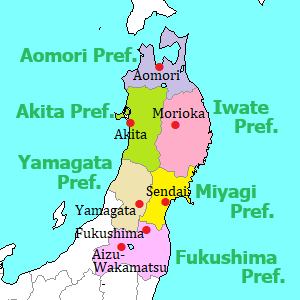
Takayama Inari-jinja (高山稲荷神社, Aomori Pref.) is a shrine located on the western coast of Tsugaru Peninsula.
There is a unique and attractive path with many Torii gates in this shrine.
Morioka Hachimangu (盛岡八幡宮, Iwate Pref.) is a Shinto shrine in Morioka city.
It was established in 1062, and several other shrines gather around the main shrine.
"Chagu-chagu Umako" festival in June is held around this shrine.
Osaki-Hachimangu (大崎八幡宮, Miyagi Pref.) was established in the northern part of Miyagi Prefecture around the 9th century, and was moved to Sendai city in 1607.
The main shrine is gorgeous and is designated as a national treasure.
Popular Shinto shrines in Kanto Region
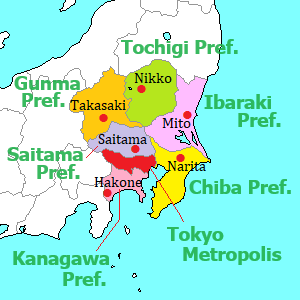
Meiji-jingu (明治神宮, Tokyo) is in the center of Tokyo and it was built for Emperor and Empress Meiji in 1920.
It is located near popular towns, Shinjuku, Shibuya, Harajuku.
Yasukuni-jinja (靖国神社, Tokyo) is also in the center of Tokyo.
It was founded in 1869 and enshrines the spirits of many people killed in the war.
Tsurugaoka Hachimangu (鶴岡八幡宮, Kanagawa Pref.) is the central shrine of Kamakura and it was founded in 1063.
Kamakura became the center of the capital city of politics from 1185 to 1333.
Nikko Toshogu (日光東照宮, Tochigi Pref.) is in the center of Nikko city, and it was completed in 1636.
Tokugawa Ieyasu, the first samurai Shogun, is enshrined as "god".
The main gate "Yomeimon" and many buildings are very gorgeous and have a lot of famous carvings.
Futarasan-jinja (二荒山神社, Tochigi Pref.) is located next to Nikko Toshogu.
It is said that this shrine was founded in 767, and it had been the central shrine in Nikko until the construction of Nikko Toshogu.
Oarai Isosaki Shrine (大洗磯前神社, Ibaraki Pref.) is a shrine by the shore facing the Pacific Ocean.
Main shrine is on the hill, but the approach leads to the sea.
The torii gate on the sea has been popular recently.
Popular Shinto shrines in Koshin-etsu Region
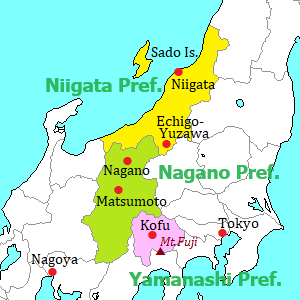
Arakura Fuji-Sengen-jinja (新倉山浅間公園, Yamanashi Pref.) is located near Lake Kawaguchi at the foot of Mt.Fuji and it was founded in 705.
There is a hill behind the shrine, and the view of the 5-Story Pagoda and Mt.Fuji is very popular.
Suwa-Taisha (諏訪大社, Nagano Pref.) is near Lake Suwa, and two shrines are on the northern side and two shrines are on the southern side.
Onbashira Festival held every 6 years is very famous.
Mount Togakushi (戸隠山, Nagano Pref.) is a mountain with Togakushi Shrine, and it is located to the northwest of Nagano city.
It has a legend of Japanese myth, and the old shrines are dotted on the slope of the mountain.
Popular Shinto shrines in Hokuriku Region
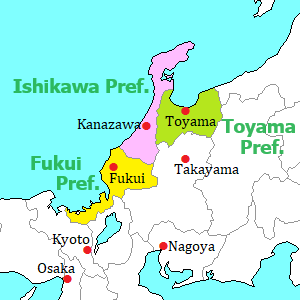
Oyama-jinja (尾山神社, Ishikawa Pref.) is located by Kanazawa Castle in Kanazawa city, and it was founded in the 1870s.
The gate is unique and is mixed with Western-style and Chinese-style.
Shirayama-hime Shrine (白山比咩神社, Ishikawa Pref.) is at the northern foot of sacred Mt.Hakusan.
In Japanese myth, it was founded in the 1st century B.C. and a goddess is enshrined.
So, if you visit and worship this shrine, you may be able to succeed in love.
Heisenji Hakusan-jinja (平泉寺白山神社, Fukui Pref.) is at the southwestern foot of Mt.Hakusan.
It was founded in 717, and a Buddhist temple was added in the 10th century.
The precinct is covered with beautiful moss.
Popular Shinto shrines in Tokai Region
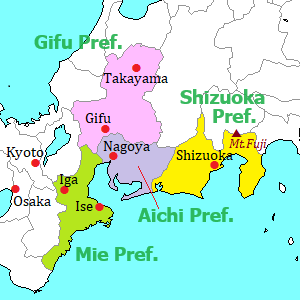
Mishima-taisha (三嶋大社, Shizuoka Pref.) is in Mishima city near Hakone and Mt.Fuji.
It is unknown when this shrine was founded, but it was an important shrine in the ancient times.
The buildings were rebuilt in the 19th century and are big and stately.
Atsuta-jingu (熱田神宮, Aichi Pref.) is in Nagoya city, and it was founded in the mythical age.
In the myth, there were three sacred treasures of gods in Ise Shrine, and one of them (a sacred sword) was carried to this shrine.
Therefore, the rank of Shinto shrine is high, so it is related to Imperial Family.
Meoto-iwa (夫婦岩, Mie Pref.) is a pair of rocks near a coast, and it is close to Ise Shrine.
The name means "rocks of husband and wife".
It is enshrined by Futami-Okitama-jinja on the shore.
Popular Shinto shrines in Kansai Region
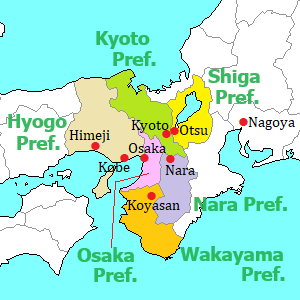
Nara and Kyoto were the ancient cities.
So, there are many important Shinto shrines in Kansai Region.
Kasuga Taisha (春日大社, Nara city) was founded in 768 when Nara was the capital of Japan (710-794).
It was the guardian god of Nara, and it had been an important shrine since then.
Tanzan-jinja (談山神社, Nara Pref.) is a Shinto shrine in the mountain.
Originally, it was founded as a Buddhist temple in 678, and it became the Shinto shrine in 1869.
Thirteen-storied Pagoda is attractive.
Kitano Tenmangu (北野天満宮, Kyoto city) was built for an excellent politician and a poet in 947.
So, a lot of students taking an entrance exam visit here.
Yasaka-jinja (八坂神社, Kyoto city) was founded in 656.
It is in Gion district, and it is the central shrine in Gion.
Gion Festival is the annual festival of this shrine.
Heian-jingu (平安神宮, Kyoto city) was built as the main construction to commemorate the 1,100th anniversary of the ancient capital city in 1895.
It was burned down in an arson attack in 1976, then it was rebuilt in 1979.
Fushimi Inari Taisha (伏見稲荷大社, Kyoto city) was founded in 711.
"Inari" enshrines the god of agriculture, and fox has been the messenger of Inari God.
The tunnel of many red Torii gates is popular.
There are some important shrines in Kansai area.
Sumiyoshi Taisha (住吉大社, Osaka city) was also founded in the mythical age.
There is a unique bridge with a shape of semicircle at the entrance.
And there are four main shrines.
Kumano Kodo (熊野古道) is the collective name of the ancient pilgrimage routes leading to Three Grand Shrines of Kumano (Wakayama Pref.).
The three shrines are Kumano Hongu Taisha (熊野本宮大社), Kumano Nachi Taisha (熊野那智大社) and Kumano Hayatama Taisha (熊野速玉大社).
The area is wide and very mountainous.
Popular Shinto shrines in Chugoku Region
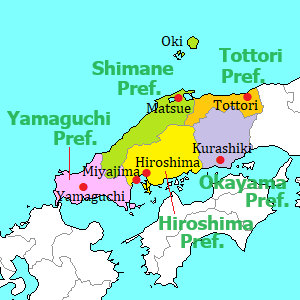
Izumo Taisha (出雲大社, Shimane Pref.) is in Izumo city and is one of major Shinto shrines.
It was founded in the oldest age along with Ise Shrine.
It is the most well-known shrine as the god of the marriage.
Itsukushima-jinja (厳島神社, Hiroshima Pref.) is on the sea in Miyajima island (宮島).
It is said that the original shrine was built in the island in 593, and the current unique and gorgeous shrine was built in 1168.
It is designated as World Heritage Site.
Motonosumi Shrine (元乃隅神社, Yamaguchi Pref.) is a small shrine near the Sea of Japan.
There is a path from the shrine to the top of rocky cliff, and a lot of red torii gates make a tunnel.
Popular Shinto shrines in Shikoku Region

Kotohira-gu (金刀比羅宮, Kagawa Pref.) is located on the mountainside in Kotohira town, and it is affectionately called Konpira-san.
The long stone steps to the shrine are famous.
Oasahiko-jinja (大麻比古神社, Tokushima Pref.) enshrines a guardian god of Tokushima, and it was founded before the middle of the 9th century.
There is a big Torii gate and a big camphor tree over 1,000 years old in the center of the precinct.
Popular Shinto shrines in Kyushu Region
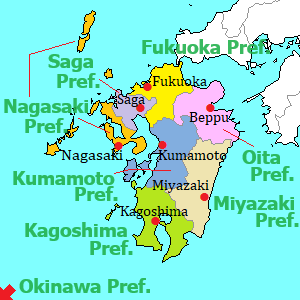
Dazaifu Tenmangu (太宰府天満宮, Fukuoka Pref.) was built for an excellent politician in 913, and a poet who had been demoted from Kyoto and died in this town.
There is a legend that an ume tree came flying from his house in Kyoto and the tree in the shrine is famous.
Yutoku Inari Jinja (祐徳稲荷神社, Saga Pref.) was founded in 1687.
The main shrine is located 18 meters above the ground, and it is supported by exposed red poles.
Amanoiwato-jinja (天岩戸神社, Miyazaki Pref.) is in the village in Takachiho Gorge.
This area is the place where the sun goddess hid in the cave in the Japanese myth.
Udo-jingu (鵜戸神宮, Miyazaki Pref.) was founded in the mythical age.
The shrine is located in the cave of the cliffside facing the Pacific Ocean.
The rocks in the cave are believed as the symbol of easy delivery and good childcare.
Kirishima-jingu (霧島神宮, Kagoshima Pref.) is the largest Shinto shrine in the southern Kyushu Island.
It is located near active Mt.Kirishima volcano.
The colorful main shrine is designated National Treasure.

